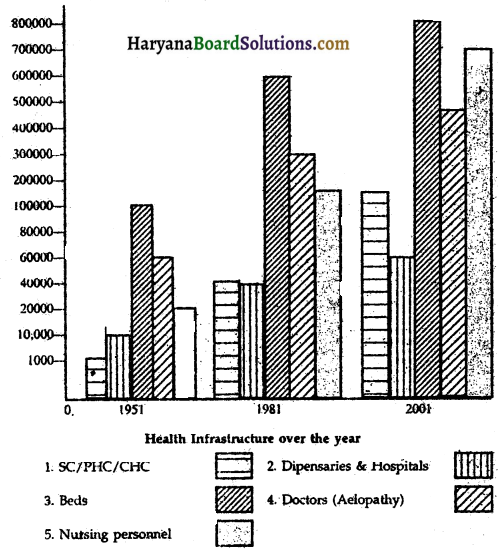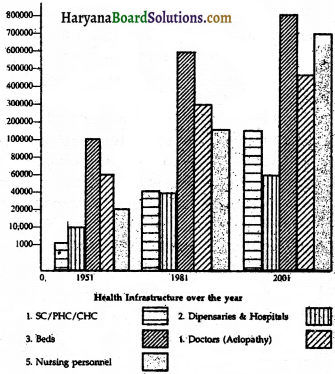Haryana State Board HBSE 12th Class English Solutions Composition Advertisement Writing Exercise Questions and Answers.
Haryana Board 12th Class English Advertisement Writing
Advertisement
What is an Advertisement?
An advertisement is a powerful medium which is used to reach out to others and to influence their minds and tastes. It is a kind of notice with a much wider appeal and effect. It is an announcement made through mass media which reaches a great number of people. Advertisers can use newspapers, magazines, posters, radio, television and cinemas to convey their messages or to sell their goods and services.
Two Types of Advertisements
Advertisements are of two types – Classified Advertisements and Display Advertisertfents. Classified advertisements are similar to notices. They differ in size and content. They are called classified because they are divided into different classes or categories such as ‘matrimonial’, ‘situation vacant’, Tost and found’ etc. Display advertisements or general advertisements are more attractive and occupy larger space. These are printed in bold letters in order to attract the attention of the readers. Whereas a classified advertisement is like a notice, the display advertisement is similar to a poster.
Difference between an Advertisement and a Matice-
(a) A notice is generally intended for a specific section of people, for example, an election notice for the students union notices for the school/college bulletin board, or notices for a club or organization. The advertisement has generally a larger or bigger appeal.
(b) A notice is a formal announcement. An advertisement can turn a bit informal with bold type, catchy phrases, broken sentences etc.
(c) An advertisement is generally commercial or matrimonial in tone, for example: ‘situation vacant’, ‘property for sale etc.

How to Draft Advertisements
Some Useful Hints:
A good advertisement is very helpful in attracting masses. Drafting an advertisement is also an art. The students should keep the following hints in mind while drafting an advertisement.
- The main aim of a business advertisement is to promote sale. So an advertisement should be attractive. It should catch the readers’ attention at first glance and then tempt them to go through it. So the language must be attractive.
- In order to attract readers, always use catchy, simple and effective language.
- The advertisement must be brief and to the point. Don’t say anything which is unnecessary or irrelevant to the main point.
- Never mislead your readers. You must be honest and don’t make claims which are exaggerated.
- The style of the advertisement must be according to the subject matter. In other words, there should be a proper mixture of style and subject matter.
- Long sentences and difficult or heavy words should be avoided. An advertisement is for spreading your message, not showing off your knowledge of language.
- While designing an advertisement, use different sizes of letters to create an attractive effect. The important points should be mentioned in bold or bigger letters.
- Although the advertisement should be brief, yet it must not be incomplete. It should be self-contained. It must convey the name of the advertiser, and other relevant information.
- In order to learn the art ofdrafting advertisements, the students should go through the classified advertisements columns of newspaper. They should also study the styles used by various display advertisements also.
- The advertiser’s address, phone number and other contact points should be clearly mentioned.
A. Classified Advertisements
Some features of classified advertisements
- Classified advertisements are printed on specific pages under different categories.
- The classified advertisements are given under different categories or types. So this category should be mentioned prominently before drafting the advertisement.
- A classified advertisement is brief. The maximum word limit prescribed in the syllabus is 50 words.
- A classified advertisement is to the point.
- The language is simple and formal.
Types of Classified Advertisements
There are many types of classified advertisements. Some of these are :
(a) Situation Vacant,
(b) Situation Wanted,
(c) Educational,
(d) Matrimonial,
(e) To Let services,
(f) Motor Vehicles,
(g) Financial,
(h) Sale and Purchase,
(i) Lost and Found,
(j) Travels and Tours,
(k) Business Proposals,
(l) Books and magazines,
(m) Career Guidance, etc.
I. Situation Vacant
1. Sunrise Construction Company requires Civil Engineers to take up various construction projects. Draft an advertisement on the firm’s behalf.
Answer:
Sunrise Construction Co. Ltd. invites applications from qualified and experienced civil engineers to supervise our construction programmes. The candidates should be first-class B.E. with at least five years experience. Salary according to qualifications and experience. Apply within ten days to M/S Sunrise Construction Co., Nirmaan Road, New Delhi.
2. Write a suitable advertisement to be published in a national daily for Paras Industries, Hisar, a leading software company, seeking franchise and/or for distributorship for the state of Karnataka.
Answer:
Paras Industries Hisar a leading software company requires franchise and/or distributorship for the state of Karnataka. The interested firms having an experience of at least five years with an M.N.C. need only to apply. Please apply within 15 days on the prescribed performance available on the website of our company.
R.K. Paras,
MD, Paras Industries
3. You are a businessman. You need a personal driver for your Honda City car. Draft a suitable advertisement. [H.B.S.E. 2017 (Set-B)]
Answer :
A businessman requires an experienced driver for his personal car, Honda City. The candidate must have at least 10 years of experience as a car driver without any record of accidents. Apply within ten days to Post Box No. 119, The Hindustan Times, New Delhi, with salary expected.
4. You require sales executives for your firm immediately and want to invite the candidates directly for interview. Draft an advertisement, announcing the date of interview.
Answer :
Wanted sales executives for our firm at Patiala. The candidates should be graduates with 2-3 years experience, in similar field. The knowledge of computer operation will be an added qualification. Appear for interview at Zenith Computers, 321 Sheela Bhawan, Patiala on 5th November between 10 a.m. to 2 p.m.
5. You are Rama/Radha, General Manager of Hotel Grand, Rohtak. You need a receptionist for your hotel. Draft an advertisement in not more than 50 words to be published in “The Tribune”, giving all the relevant details. [H.B.S.E. March 2019 (Set-A)]
Answer :
Hotel Grand, Rohtak needs a receptionist for the hotel. Candidates with a degree or diploma in Hotel Management, age not above 25 years may apply to the Manager before 10 April, 20 ……………….. with complete biodata and one recent coloured photograph. Only short-listed candidates will be called for interview special. Preference to females. Radha, Manager Ph. No. 50507…………………… .

6. You are the Director of a Charitable Hospital. Draft an advertisement for an eye surgeon for your hospital.
Answer:
Wanted a qualified eye surgeon for our hospital. The candidate must possess a Post-graduate degree in eye surgery and a minimum five years experience in a reputed hospital. The starting salary is around 25,000 per month with other benefits like free accommodation. Apply with bio-data, within ten days to the Manager, Mother Teresa Hospital, Nicholson Road, New Delhi.
7. You are the Managing Director of Ratlam Overseas Ltd., Ludhiana. You need a Chartered Accountant for your Chandigarh office. Draft an advertisement, inviting applications for this post.
Answer:
Applications are invited from qualified and experienced candidates for the post of a Chartered Accountant for our Chandigarh branch. The initial salary will be Rs. 15,000 with free accommodation. Apply within seven days to the Managing Director, Ratlam Overseas Ltd., Sarabha Nagar, Ludhiana giving details of your qualifications and experience.
II. Situation Wanted Or Job Wanted
8. You want a job in an advertising company as a copywriter. Draft a suitable advertisement.
Answer :
Services of a well-educated, qualified and experienced part/full-time copywriter available. Can make advertisements for newspapers/magazines; can write attractive slogans and punch lines. Contact Harish Bhimani, 315 Panchkuian Road, Connaught Place, New Delhi or contact 011-5693197, Sunday any time, other days after 5 p.m.
9. You are commerce graduate and require a suitable job. Draft an advertisement giving your details.
Answer:
A first-class commerce graduate seeks a suitable job in a reputed firm to work as an accountant/ assistant/secretary. Three years experience, a good knowledge of English and accounting. Also has working knowledge of computers. Minimum salary acceptable is Rs. 14,000 per month. Contact Rajiv Kumar Z-2 West Patel Nagar, New Delhi.
10. You are computer professional having knowledge of both hardware and software and want a suitable job. Write an advertisement accordingly.
Answer:
A young computer professional with First Class MCA degree seeks a suitable job. He has knowledge of both software and hardware. He knows programme and tally (accounts) also. Minimum salary acceptable is Rs. 10,000 per month. Contact Maghesh Kumar Shrivastava, 20 Tankara Road, New Delhi or contact 011-5130070.
11. You are a fresh engineering graduate and want a job in a reputed company. Draft a classified advertisement offering your services.
Answer:
A young and dynamic engineering graduate seeks a suitable job in a reputed company. The candidate is First Class Graduate in Mechanical Engineering from Delhi College of Engineering. Minimum salary expected is Rs. 20,000 per month. Write to Talash Chander, 248 Rojgar Colony, New Delhi within seven days with the salary offered.
III. Educational
12. You are the Principal of a senior secondary school. Draft an advertisement announcing admissions to your school. [H.B.S.E. 2017 (Set-A)]
Answer :
Vidya Mandir Sr. Sec. School, Ghaziabad. Admissions are open for Xth, Xlth and XII class in our school. Limited seats are available. Our school is one of the foremost schools of this area and has experienced and hard-working staff. Spacious buildings and big playgrounds. Top position in results. Last day for submission of applications is 20th July.
13. You are Monika of 1460, Sector – 14 Rohtak. You want a maths teacher for your son who is in XII class. Draft a suitable advertisement stating your requirements. [H.B.S.E. March 2018 (Set-A)]
Answer :
A maths tutor is required to give coaching to a XII class boy of Govt. Sr. Sec. School, Sector-7 Rohtak between 7 p.m. to 9 p.m. at our residence 1460, Sector-14 Rohtak. Contact : Monika Ph. No. 9997770102.

14. You are running a private study centre which teaches different languages and also gives coaching for competitive examinations. Draft a suitable classified advertisement for this purpose.
Answer:
Learn English, French, German and Japanese languages in three months. Also coaching for various competitive examinations. Languages are taught with the help of video/audio cassettes stnd computers. Regular/ postal courses available. Limited seats. Contact Rajpal Katyal, Katyal Language Academy, B-9 Fateh Nagar, New Delhi.
IV. Career Guidance and Placement Services
15. You are running a Career Counselling Service. Draft an attractive advertisement selling your services and apprise the students of the careers to be adopted by them.
Answer :
What To Do After XII?
Don’t be frustrated if you cannot decide what career to adopt after passing XII. We have a panel of experts in order to guide you according to your marks, tastes and aptitude. Very nominal guidance fee. Meet today, Sangma Career Counselling Agency, 432, Picaddily, Chandigarh.
16. You are running an agency, Ambani Consultants, helping young entrepreneurs in setting up business. Draft an advertisement for this purpose.
Answer :
Do you want to set up your own business? Come to us for complete guidance regarding what type of industry to choose, how to arrange finances, getting licences and other necessary things. We arrange loans from nationalised banks also. Consult Ambani Consultants, 549 Vit Marg, New Delhi.
17. You are the Director for the Institute of Career Guidance, Counselling and Placement Services. Draft a suitable advertisement for this purpose.
Answer :
Career Guidance And Counselling
We are a renowned institute of career guidance. Our experts will guide you to select the right career according to your qualifications and aptitude. Job placement in reputed firms and business houses is also assured. Contact, Director, Career Guidance and Counselling Bureau, 45, Nehru Place, New Delhi.
18. You run a placement service and specialize in clerical and security jobs. Draft an advertisement about your services.
Answer :
We handle all types of security requirements and also office personnel. We have a number of candidates on our panels. Offices, firms, business houses may contact us for their requirement of employees. Tony Blair Placement Services, 10 Browning Lane, Kolkata.
V. Matrimonial
19. Write out a matrimonial advertisement for publication in a newspaper for a suitable match for your sister.
Answer:
Bridge Room Wanted
Wanted a suitable match for a smart, convent-educated, beautiful and cultured Punjabi Khatri girl, M.A. (Eng.), height 5.2″, 23 years, small educated family. Boy’s merit main consideration. Boy in good service or business preferred. Write to Box No. 3429 NH, Hindustan Times, New Delhi.
20. Write out a matrimonial advertisement for a newspaper using the information given below: Aggarwal, homely girl, 25 yrs., respectable family, -looking for highly educated match.
Answer:
Wanted a suitable match for a smart homely girl, age 25 years, height 5.5″, fair complexion, belonging to a respectable Aggarwal family, settled in Delhi. MBA with additional qualification in computer applications, currently working as an executive in a reputed firm. Looking for a well-settled match from a reputed family. Write to Box No. 3419-CA, Hindustan Times, New Delhi 110001.
21. You are looking for a match for your smart, convent-educated daughter. Draft a matrimonial advertisement for a newspaper.
Answer:
Alliance solicited for a smart, convent-educated, soft-spoken and cultured girl, M.Sc. (Chem.), age 24 years, 5.6″, computer literate. Looking for similar status, early decent marriage. Write to Box No. WP- 1079 the Hindustan Times, New Delhi, 110001.
22. Draft a matrimonial advertisement for your brother who is an engineer and an MBA and is in family business.
Answer:
Bride Wanted
Wanted suitable match for 26 years old 5.8″, smart, handsome, engineer boy, done his MBA from England and is engaged in parental business of monopoly brass hardware manufacturing and its export to western countries. Girl’s merit is the only consideration. Send bio-data and horoscope. Box No. 3211, Hindustan Times, New Delhi.
VI. Lost and Found
23. You have lost your file containing original certificates in a bus. Write a short classified advertisement for a newspaper. Announce a reward also. [H.B.S.E. 2017 (Set-C)]
Answer:
Lost! Lost! Lost!
I lost my file in the local DTC bus while travelling from Dhola Kuan to Punjabi Bagh. The file contains my original certificates and other important papers. The finder is requested to return it at the following address. Areward of Rs. 2000 will be given to the finder of the file. Contact: Ram Lai, 285 Punjabi Bagh (East), New Delhi.
24. Your name is Rama. You have lost your gold necklace while you were taking a walk in the garden. Draft an advertisement for this purpose. [H.B.S.E. 2017 (Set-D)]
Answer :
I have lost my gold necklace while I was taking a walk in the Alfred Park, Andheri (East). It is a costly necklace and is a gift to me from my uncle. Anybody who has found it may kindly return it at my address. The finder will be given a reward of Rs. 5000. Rama, 432 Juhu, Mumbai.

25. A boy of 14 years has been missing for a month. On behalf of the boy’s parents, write an advertisement for the ‘Missing Persons’ column of a newspaper.
Answer:
Missing since 15th July, a young boy of 14 years, height 5’5″, fair complexion, strong body and a cut above his right eye. He was in a brown pant, white shirt and black shoes. He speaks Hindi and Punjabi. Anyone giving his whereabouts will be suitably rewarded. Please contact: Vinod Kambli, 345 Prahalad Nagar, New Delhi.
26. You lost your golden wristwatch while playing in the school playground. Draft a notice for the school board.
Answer :
Lost my golden watch on Tuesday while playing in the school ground. The watch has a black leather strap. Anyone who finds it, may return it to me or deposit it to the school head boy. The finder shall be suitably rewarded. Please Contact: Sandeep Kumar, Class XII, Roll No. 321.
27. You have found a suitcase while travelling by a train. Write an advertisement for the ‘Lost and Found column of a newspaper.
Answer:
While travelling by Lucknow Mail from Lucknow to New Delhi, I found a suitcase. The suitcase is locked. It will be handed over to its rightful owner after he gives its particulars, identification marks and the contents. Please contact Som Nath Miglani, 45 Supriya Vihar, Delhi, or phone 5140070.
VII. Sale/Purchase
28. You have been transferred to Chennai and you want to sell your old Maruti 800 car. Write a suitable advertisement for a newspaper.
Answer :
For sale, a Maruti 800 car 2005 model, in excellent condition, owner driven; new tyres and tubes; price expected Rs. 80,000. Contact Chetak Singh, 439, Gita Colony, New Delhi, Phone: 6543321.
29. You want to sell your antique drawing room decorations, gramophone etc. Draft a suitable advertisement for publication in a daily newspaper.
Answer:
For sale antique decorations, gramophones, pianos, kerosene fans, lamps, heaters, miniature paintings, wall-clocks, glass and brass artefacts; coins of different countries and other antique things. Contact: Rajneesh Behl, 467 Rajouri Garden, New Delhi, or telephone 5668543 between 5 p.m. to 10 p.m.
30. You have two houses in Panchkula and want to sell them as you have settled in Mumbai. Draft an advertisement for a newspaper.
Answer :
For sale fourteen Marla Duplex Kothi, newly built sector 4, Panchkula and 7 Marla Comer Kothi Double Storey, Sector 4, Panchkula. Contact B.D. Sharma and Sons. 32 Madhya Marg, Panchkula or telephone 572680, 560430.
31. You want to purchase a house in Delhi. Draft a suitable classified advertisement for publication in a newspaper.
Answer :
Wanted one kanal kothi with attached lawn, and modem fittings in the rooms, in Defence Colony, Lajpat Nagar, or Chanakyapuri areas. Good price offered for a really good Kothi, immediate possession wanted. Contact R.K. Begharia, 35 Shivananda Marg, Karol Bagh, New Delhi or phone: 5368652.
32. You want to sell your car as you are shifting from Bangalore to Delhi. Draft a suitable advertisement to be published in ‘The Times of India.’ Give necessary details of the car. You are Prateek/Reena, 240, Sector-4, Sonipat. [H.B.S.E. March 2018 (Set-C)]
Answer:
An old car Maruti Suzuki Swift 2014 Model, White colour, is for sale as the owner is shifting from Bangalore to Delhi the next Sunday. Interested persons may contact to Prateek, 240, Sector 4, Sonipat Ph. No. 6663331111.
33. You are Mahima/Mahesh. You plan to sell your two-wheeler. Draft an advertisement in not more than 50 words to be published in “The Tribune”, giving all the relevant details. [H.B.S.E. 2019 (Set-D)]
Answer:
A Honda Activa 2015 Model, Black colour, very good condition, only 3000 kilometres driven is for sale as the owner is going abroad for two years. Interested persons may please contact Mahesh 502 A, Sector 4, Kamal. Ph. 93907………………. .
34. You are a business consultant and you offer your services for establishing different kinds of industries. Draft a classified advertisement for offering your expertise in setting up a Peppermint Industry.
Answer:
Establish new export-oriented Menthol Kristal Peppermint industries. For full details of raw materials and sale of finished products against cash payment and for loan, contact: Kajol Menthol Enterprises 132-A/l, Labhowal Road, Pathankot.

35. You are Sudha/Sudhir of Model Town, Sonipat. You wish to purchase some property in Hisar. Draft an advertisement in not more than 50 words to be published in “The Tribune”, giving all the relevant details.
Answer :
Sudhir of Model Town, Sonipat Ph. No 90507 wishes to purchase some property in Hisar. The property may include a 10-maria plot or constructed house in any HUDA-Sector, a commercial plot or constructed avenue. Please contact the earliest. [H.B.S.E. March 2019 (Set-C)]
VIII. To Let
36. You want to let out a portion of your house. Draft a suitable advertisement giving details to be published in the ‘To Let’ column of a newspaper, giving your contact number as telephone 625214.
Answer :
To let, a portion of newly constructed house, in Mayur Vihar, New Delhi. Three bedrooms attached washroom, drawing, dining, kitchen and car parking facility is also available. Rent around Rs. 5,000 p.m. Employees or ladies preferred. Contact N.M. Khanna, 654 Phase II, Mayur Vihar, New Delhi, or telephone: 625214.
37. You are Nikhil of 91, Laxmi Nagar, New Delhi and wish to let out a portion of your newly built house. Draft an advertisement for publication in the ‘To Let’ column of the Hindustan Times, New Delhi, giving all necessary details like location, type of accommodation to be rented out, rent expected, contact address, including the telephone number etc.
Answer:
To let, a portion of newly built house in Laxmi Nagar, New Delhi. Four bedrooms with attached washroom, drawing and dining. Space for parking and servant’s quarter. The rent expected is Rs. 10,000 per month. Small families preferred. Contact Nikhil 91, Laxmi Nagar, New Delhi, or contact on telephone No. 2222821 after 5 p.m.
38. You are running a ‘To Let’ service in New Delhi. Write out an advertisement for the ‘To Let’ column of a newspaper giving details of the property available to let.
Answer :
To let, independent house, flats, portions of spacious house, single rooms, two-room sets, etc. in Tilak Nagar, Moti Nagar, Mahabir Nagar, Subhash Nagar, Pashchim Vihar and adjoining areas. Reasonable rents. Ready possession. Contact Amisha To Let Services, 54/1 Tilak Nagar, New Delhi.
39. You are Ramesh/Ramana, the owner of an independent house in D-Block, Sector 4, Sonipat. You plan to sell it off. Draft an advertisement in not more than 50 words to be published in “The Tribune”, giving all the relevant details. [H.B.S.E. March 2019 (Set-B)]
Answer :
An Independent house of 10 maria in D-Block, Sector-4, Sonipat is for sale. The house includes two storeys with 3 bhk set on the ground floor and 2 bhk set on the 1 st floor. Fully furnished, park facing, 40 feet front road. Interested parties may contact Ramesh Ph. No. 90990……………….. .
B. Display Advertisements OR General Advertisements
40. M/s Ambani Brothers have launched a new refrigerator named ‘Whirlpool’. Draft an advertisement to be published in a newspaper to promote the sale of the refrigerator.
Answer:

41. You are the Director of Zenith Academy which provides postal/classroom coaching to students appearing for Engineering and Medical entrance tests. Draft a display advertisement for your academy.
Answer :
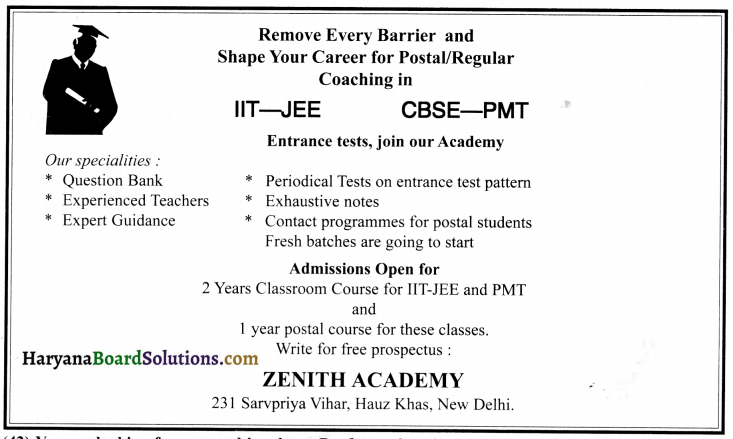
42. You are looking for a second-hand car. Draft an advertisement for a newspaper specifying your requirements.[H.B.S.E. March, 2018 (Sei-B)]
Answer :


43. You are working for an advertising agency. Draft an advertisement for a Company which is launching a Herbal Toothpaste. Imagine details. [H.B.S.E. March 2020 (Set-B)]
Answer:

44. A new motorcycle is to be launched. Prepare an advertisement highlighting its qualities. [H.B.S.E. March. 2018 (Set-D)]
Answer :
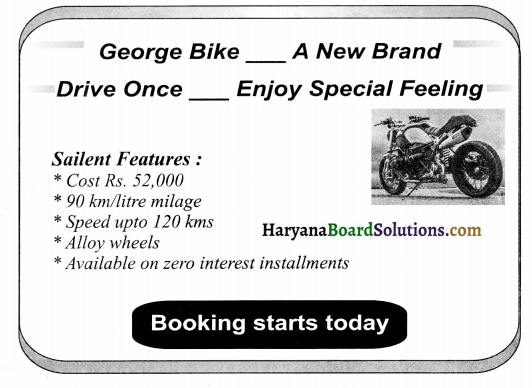
45. You are the proprietor of Hotel Garhwal Terraces, Darjeeling. Draft a display advertisement announcing a cut in the rates and about special facilities.
Answer :
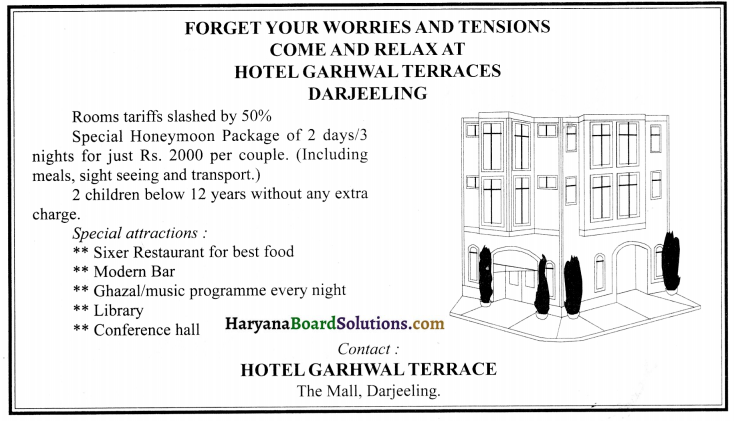
46. You are running a finance company and provide loans for purchasing cars. Draft an advertisement highlighting your services.
Answer :

47. You are working for an advertising agency. Draft an advertisement for an Ayurvedic Face Cream. Imagine details. [H.B.S.E. March 2020 (Set-C)]
Answer :

Exercises For Practice
1. You are the Personnel Manager of a firm. You need an accountant for your office. Draft a classical advertisement for the ‘Situation Vacant’ column of a newspaper.
2. You run a computer centre and offer your services for job work like computer type-setting, software preparation, accounting work etc. Write out an advertisement offering these services to the needy persons.
3. You are the proprietor of a hotel. You need a lady receptionist. Draft an advertisement to this effect. Mention that the lady should be fluent in English.
4. You need salesman for door-to-door selling of the washing powder manufactured by you. Write out an advertisement for the ‘Situation Vacant’ column of a newspaper.
5. You have a big house in a posh colony in New Delhi. Write out a classified advertisement for letting out some portion of your big house. Also, mention the rent expected by you.
6. Your younger sister is weak in English and Maths. You want to engage a tutor who can teach her at your house. Draft an advertisement for the ‘Situation Vacant’ column of a newspaper.
7. You run an authorised Pollution Check Centre and issue ‘Pollution Under Control’certificates to vehicle owners. Draft a display advertisement, telling the public the harmful effect of gases if the vehicles are not regularly checked.
8. Your young sister has just passed her M.A. You want to find a suitable life partner for her. Write out an advertisement for the ‘Matrimonial’ column of a newspaper.

9. You have lost your briefcase in a bus. The briefcase contained important documents. Draft an advertisement for the ‘Lost and Found column of a newspaper. Announce a suitable reward for the finder of the briefcase.
10. You are the director of Prakash Institute which is a leading name in the coaching of IIT-Jee and CBSE- PMT examinations. Draft a display advertisement highlighting the qualities of your Institute. Announce the date of admissions also.
![]()
![]()
![]()
![]()
![]()








